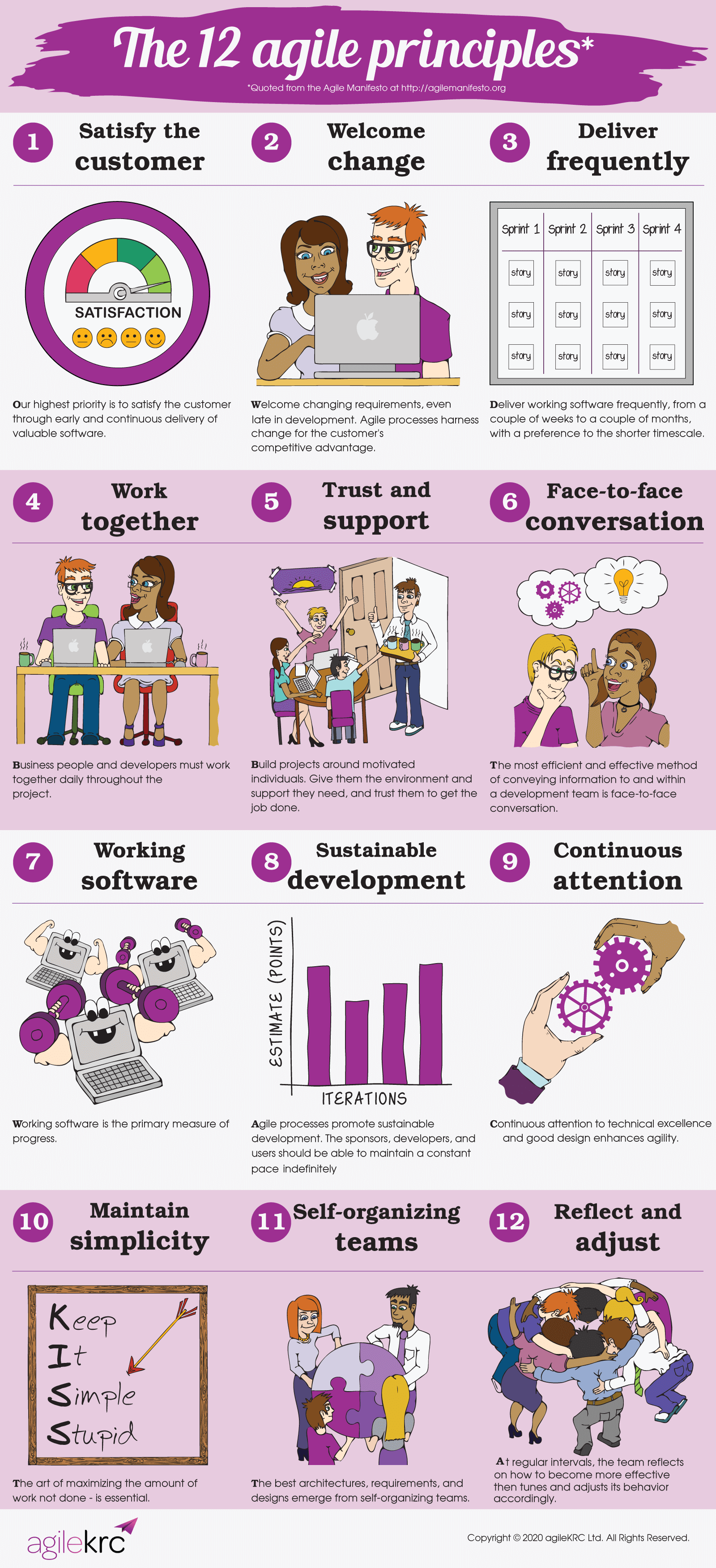
Agile’s Impact on Software Development
Agile has become a defining force in the software development industry, thanks to its 12 Agile Principles and are described in the Agile Manifesto that guide teams in the rapid and efficient development of high-quality software products.
Breaking down the Agile principles
The 12 Agile Principles form the cornerstone of the Agile methodology, shaping every aspect of Agile project execution. In this article, we will investigate these principles and their crucial role in fostering the success of Agile projects.
1. Our highest priority is to satisfy the customer through early and continuous delivery of valuable software.
The foremost Agile principle revolves around customer satisfaction, achieved by promptly and consistently delivering valuable software.
This principle emphasises the importance of delivering a minimum viable product (MVP) that aligns with customer needs and can be produced within a short time frame.
By presenting a functioning product early on, the customer can offer feedback regarding the software’s capabilities and pinpoint any necessary adjustments. This guarantees that the final product aligns with customer expectations and is completed punctually.
2. Welcome changing requirements, even late in development. Agile processes harness change for the customer’s competitive advantage.
The second Agile principle encourages embracing changing requirements, even during the latter stages of development.
This principle recognises that requirements may shift throughout the development process, and the Agile methodology is structured to adapt to these alterations.
By accepting change, the team can guarantee that the final product aligns with the customer’s changing demands.
3. Deliver working software frequently, from a couple of weeks to a couple of months, with a preference to the shorter timescale.
The third Agile principle advocates for frequent delivery of working software, favouring shorter timeframes.
This principle emphasises the importance of providing small, progressive updates to the software consistently, rather than postponing delivery until the conclusion of the development cycle.
By adopting this approach, the team can guarantee that the software undergoes testing and validation throughout the development process, minimising the potential for delays and mistakes.
4. Business people and developers must work together daily throughout the project.
The fourth Agile principle underscores the importance of consistent collaboration between customers and stakeholders throughout the entire project duration.
This principle focuses on the crucial role of ongoing communication and feedback between the team, the customer, and other involved stakeholders.
By forging a strong working partnership with the customer, the team can ensure that the software fulfils their requirements and expectations, and by incorporating stakeholders in the process, the team can ensure that the software meets broader business ambitions and objectives.
5. Build projects around motivated individuals. Give them the environment and support they need, and trust them to get the job done.
The fifth Agile principle focuses on the development of projects that incorporate enthusiastic individuals, providing them with the proper environment and backing, and relying on their expertise to execute the job.
This principle stresses the importance of cultivating a favourable setting where team members can work independently, own their tasks, and work cohesively with others.
By empowering individuals and trusting their decision-making skills, the team can attain more successful outcomes.
6. The most efficient and effective method of conveying information to and within a development team is face-to-face conversation.
The sixth Agile principle stresses that the most competent and effective approach for passing on information within and to development teams is via face-to-face dialogue.
This principle underlines the essential nature of communication in every Agile method and proposes that one-on-one conversations are the best way to relay information, navigate obstacles, and reach conclusions.
7. Working software is the primary measure of progress.
Agile’s seventh principle establishes that the pivotal indicator of progress is working software.
This principle highlights the necessity of providing a functional product at each juncture of the development process.
By assessing progress according to the software’s capabilities, the team can verify that they are delivering value to the customer and reaching project goals.
8. Agile processes promote sustainable development. The sponsors, developers, and users should be able to maintain a constant pace indefinitely.
The eighth tenet of Agile practices underlines that Agile processes encourage sustainable development, with all stakeholders capable of maintaining an unwavering pace indefinitely.
This tenet highlights the significance of a sustainable development process, allowing the team to keep a steady pace throughout extended periods.
By evading lengthy hours and burnout, the team can maintain high levels of productivity and persist in delivering excellent software over the long term.
9. Continuous attention to technical excellence and good design enhances agility.
Agile principle number nine posits that unwavering commitment to technical excellence and effective design boosts agility. This principle stresses the value of technical mastery and superior design during the development process.
By focusing on these aspects, the team can ascertain that the software is maintainable, scalable, and sturdy, ultimately improving its agility and capability to meet shifting requirements.
10. Simplicity – the art of maximising the amount of work not done – is essential.
The tenth Agile principle maintains that simplicity – the capacity to maximise the amount of work not done – is of great importance.
This principle accentuates the necessity of directing attention to the indispensable aspects and shunning unnecessary tasks.
By lowering the amount of work that must be done, the team can decrease waste, enhance efficiency, and speed up the delivery of the product.
11. The best architectures, requirements, and designs emerge from self-organising teams.
The eleventh principle of Agile methodologies asserts that self-organising teams are the most optimal source of superior architectures, requirements, and designs.
This principle acknowledges the team’s unparalleled knowledge and proficiency in software development.
By fostering collaboration and allowing the team to make decisions, the team can create exceptional solutions that address the customer’s requirements.
12. At regular intervals, the team reflects on how to become more effective, then tunes and adjusts its behaviour accordingly.
Agile’s twelfth principle maintains that at regular intervals, the team should reflect on how to become more effective and modify their behaviour accordingly.
This principle acknowledges the importance of continuous improvement and feedback in the development process.
By regularly evaluating their performance and identifying areas for improvement, the team can enhance their efficiency, effectiveness, and overall quality of work.
Agile Principles: Streamlining Product Development
The 12 Agile principles are instrumental in streamlining the product development process. They provide a comprehensive framework for the entire process, ensuring that the team delivers a high-quality product that meets the customer’s needs.
For instance, the first principle emphasises customer satisfaction through early and continuous delivery of valuable software. This principle guides the team to focus on delivering a minimum viable product that meets the customer’s requirements and can be delivered quickly. By doing so, the team can obtain feedback from the customer and adjust the product as necessary.
Similarly, the fourth principle emphasises collaboration with customers and stakeholders throughout the project. This principle guides the team to involve them in the development process, ensuring that the product meets their needs and aligns with broader business objectives.
The sixth principle emphasises face-to-face conversation as the most efficient and effective way of conveying information within the development team. The team prioritises face-to-face communication to ensure that information is shared effectively, and issues are resolved quickly.
The twelfth principle emphasises the team’s continuous improvement efforts. The team regularly evaluates its performance, identifies areas for improvement, and adjusts its behaviour to enhance its efficiency, effectiveness, and overall quality of work, ultimately streamlining the product development process.
Conclusion
The Agile principles enable agility and adaptability in product development, providing a roadmap for delivering high-quality software that meets the customer’s needs and aligns with broader business objectives. Collaboration, communication, feedback, and continuous improvement are the cornerstones of these principles, allowing Agile teams to enhance their productivity, agility, and overall effectiveness.
The Agile principles also emphasise the importance of adaptability and flexibility in today’s fast-changing business landscape. By prioritising customer satisfaction, early and continuous delivery, and a rapid response to change, Agile teams can develop solutions that meet changing needs and deliver real value to customers and the broader business.
These Agile principles provide a solid foundation for all Agile approaches and methods, guiding every step of the Agile development process. These principles stress collaboration, communication, feedback, and continuous improvement, which are essential for developing high-quality software that meets customer needs and adapts to changing requirements.
By following these principles, Agile teams can enhance their agility, productivity, and overall effectiveness and develop solutions that provide tangible benefits to the customer and the broader business.
agileKRC has helped shape agile thinking by leading the teams that developed AgilePM® and PRINCE2 Agile®. We take a practical, success-oriented approach. We begin by taking the time to listen and understand your needs, before offering our real-world experience and expert guidance.














